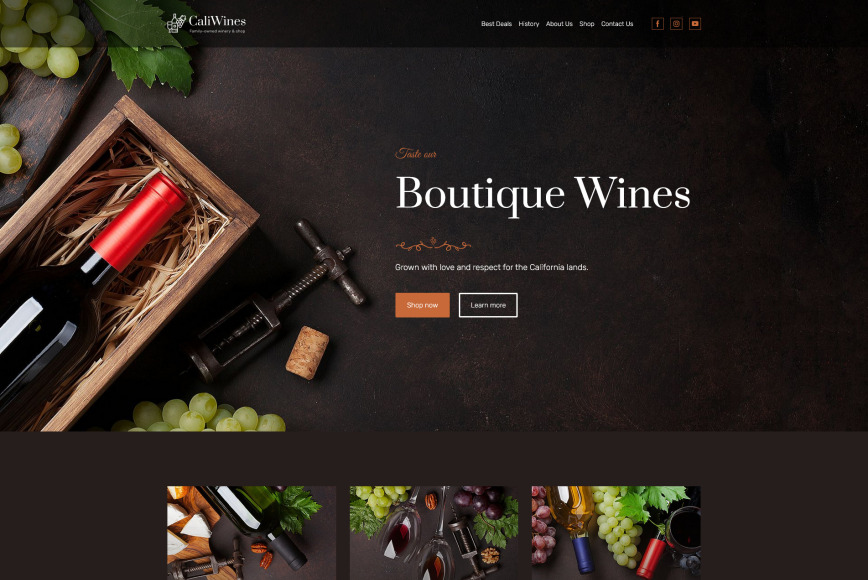With the global economy screeching to a halt amid the rapid spread of the coronavirus, how do you plan to keep your ecommerce business profitable?
There’s no denying that the global economy has been and will continue to be disrupted for the next several months due to the pandemic. While restaurants, retail stores, offices, and factories temporarily cease operations to help combat the spread of the virus, the threat of a global recession doesn’t seem far off. Some are saying it’s already here.
But here’s the thing…
While it’s easy to get pessimistic about the prosperity of your online business during challenging times, there are actions you can take that increase your chances of surviving, or even thriving, during economic downturns.
As fears about the global pandemic loom over the heads of consumers, now is the time for companies to start taking the necessary steps to prepare for a recession. In this report, we’ll be focusing on the impact that COVID-19 has had on ecommerce businesses thus far, and then discuss how companies can use times of economic decline to their advantage.
Here’s what we’ll be covering:
How has the ecommerce industry been impacted?
The need to be lean
Focusing on your high-value customers, products, and channels
How to create the highest customer lifetime value (LTV)
Where conversion rate optimisation comes in
How has the ecommerce industry been impacted by the pandemic? To get a clearer understanding of the impact that the pandemic has had on the ecommerce industry thus far, we conducted an initial survey of our audience (mainly comprised of ecommerce store owners/managers) in March 2020.
Less than two months later, we re-distributed the survey to see how responses had changed. Here’s what we learned: Ecommerce sales have taken a hit, but not for everyone. Despite consumer confidence being on a steady decline since mid-March in the U.S., ecommerce sales only seem to be partially impacted by the pandemic.
The initial survey results showed a nearly equal split between ecommerce businesses that had and had not experienced a negative impact on total sales. Ryan Garrow – Director of Partnerships and Client Solutions at Logical Position– had some interesting data to share regarding the positive impact that COVID-19 has had on their 4000+ clients’ online shopping impressions since mid-February:
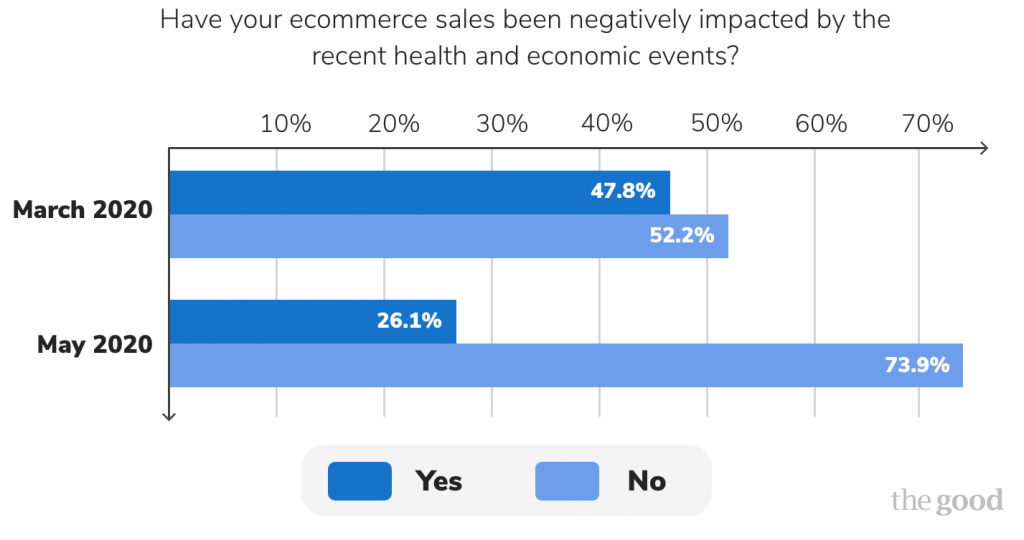
This data is clearly pointing to a shift in consumer shopping habits, and we’re predicting that the number of online businesses being negatively impacted by the pandemic will continue to diminish over the next several months.
Many ecommerce businesses expect to start spending more on marketing.
It’s no secret that marketing is often the first target when it comes to reducing operating costs. Of respondents in the first round of our survey, 60.9% predicted that they would likely reduce marketing spending if economic conditions continue to worsen.
What’s surprising is that only 4.3% of respondents said they would focus on reallocating their marketing budget to spend less in some areas, and more in others.
When we asked the same question just over a month later, the response was a bit more encouraging.
Now, only 34.8% of respondents predict that they’ll reduce marketing spend, and over half (52.2%) plan to spend more on marketing in the coming months. We also found that 8.7% of respondents believed that they would likely respond to the economic impact of the pandemic by pivoting their brand direction. Only 4.3% of respondents reported that they would be reallocating their current marketing spend.
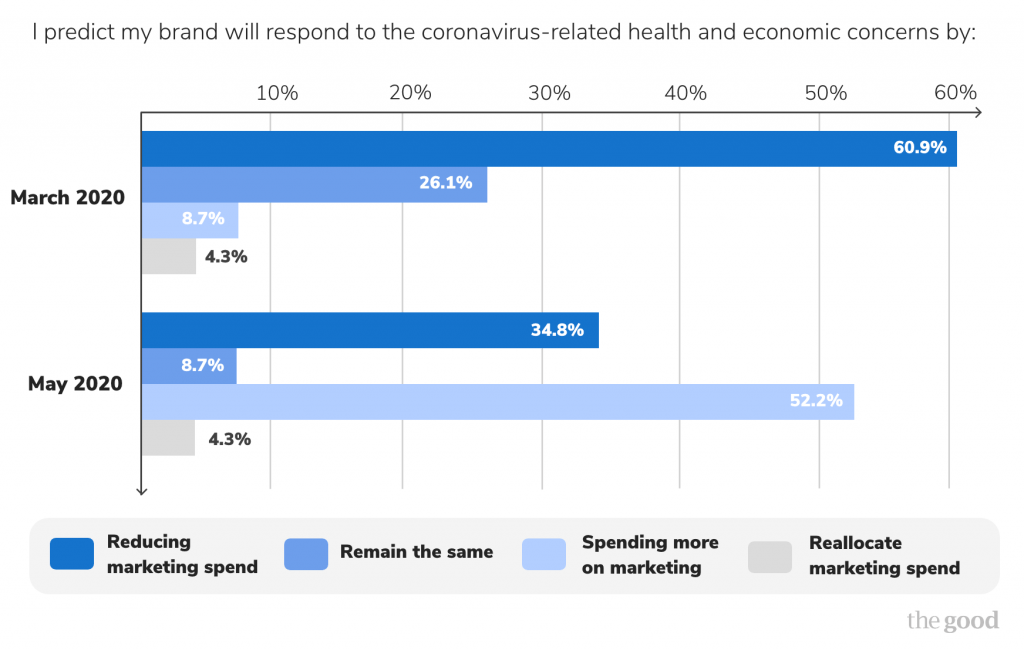
This is encouraging data to see as it proves that confidence among ecommerce business owners is rising. In times of recession, it’s always the companies that invest more in marketing that come out stronger on the other side. If you can increase visibility for your brand during times of economic slowdown, you’ll be top-of-mind with your target audience when things begin to return to normal.
Ecommerce store owners are expecting to see sales grow as consumers move online for their shopping needs.
Initially, over half (52%) of survey respondents said that they expected to see their ecommerce sales grow as a result of the coronavirus. Despite dropping consumer confidence, it’s very possible that the ecommerce industry could weather the storm fairly unscathed.
From the updated survey results, we found that 91.3% of respondents expected to see their ecommerce sales grow as more consumers adapt to online shopping during the pandemic. Only a small percentage of survey respondents (8.7%) anticipated sales to diminish.
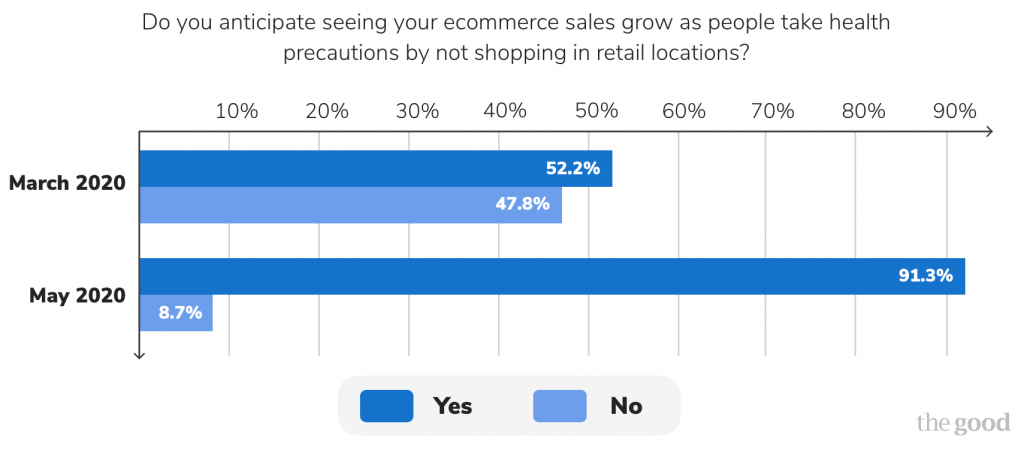
This points to a significant increase in confidence from online business owners. We’re predicting that as the industry continues to thrive over the next several months, this confidence will continue to rise in the DTC community.
Economic slowdown remains a top concern for ecommerce managers.
In our first round of survey results, 34.8% reported that out-of-stock events were a top concern right now. Supply chain constraints have triggered a variety of problems for ecommerce businesses, the largest of these being delayed shipping times and a lack of inventory/materials.
Not surprisingly, economic slowdown continues to be the biggest concern for a majority of ecommerce business owners. The economic disruption we’re currently in will be felt for many months to come, so it’s only natural to assume that businesses are worried about the economy screeching to a halt.
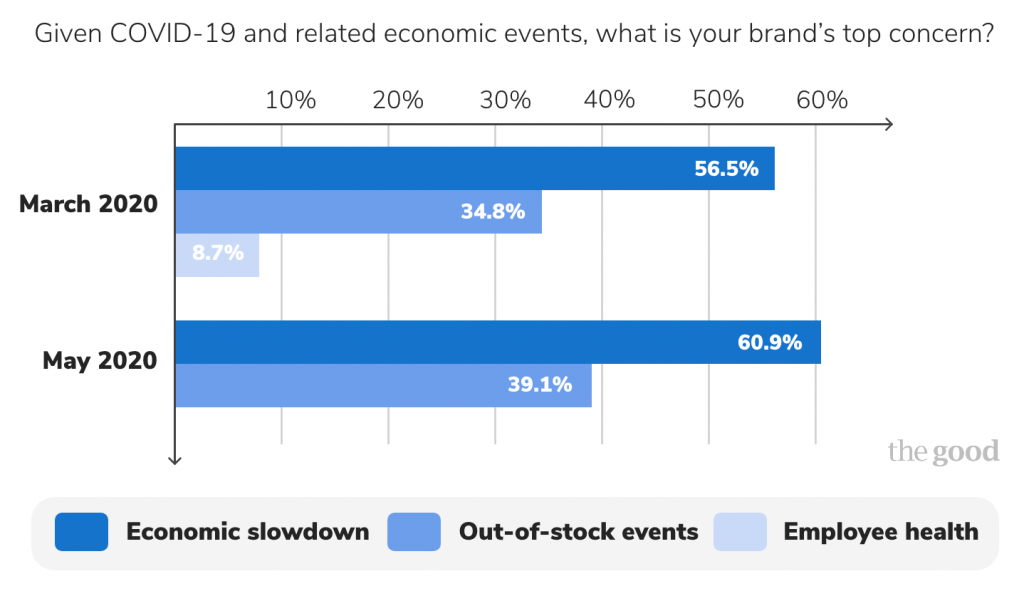
An important thing to note is that even if the economy sinks deeper into a recession with consumers staying at home, people will continue to buy products online. The ecommerce industry may have been slightly impacted by ripples from the pandemic, but ultimately this event has solidified the fact that online shopping is the future. Brick-and-mortar retail will never be the same after this event, and the brands that haven’t acknowledged that yet will be hit the hardest in the wake of the pandemic.
The Need To Be Lean
So how do you get a business to thrive in an economic downturn? The answer is clear: You have to go lean and mean.
Specifically, you need to be able to get maximum ROI from your marketing spending by increasing your return on ad spend (ROAS). When you maximize ROAS, your traffic generation efforts are much more effective and your customer acquisition cost (CAC) significantly falls.
Here’s what you need to understand:
High-performing brands can increase their ROAS and decrease their CAC by diversifying their marketing efforts to unpaid and lower-CAC channels. Instead of simply putting up with increasing PPC costs and lower margins, the most effective brands get creative with their marketing efforts. They find the marketing channels and techniques with the highest ROI and then double down on them.
These companies understand that they don’t have to keep doing things the way they’ve always done them. Rather, through strategic optimisation, they can significantly improve their marketing results.
If you can optimise your business and website for your best clients, your CAC will significantly fall. Instead of having to shell out large amounts of cash to keep acquiring new customers, you can rely on your best customers to buy from you again and again.
As a bonus, you’ll probably acquire some new clients along the way.
Put simply, to thrive during any sort of downturn, you need to be able to:
- Reduce costs
- Increase profits
- Reduce waste
But how exactly do you achieve these things? How do you become a high-performance brand that gets a high ROAS, high average order value (AOV), high conversion rates, and low cart abandonment? How do you become an ecommerce business that thrives under pressure?
It’s all about value focus:
- Focus on your highest-value customers
- Focus on your highest-value products with the best margins
- Focus on your highest-value channels
- Focus on creating the highest customer value
When you optimise your ecommerce website for each of these items, it enables you to thrive when others are struggling. To surge forward while others are falling behind. To stay profitable when others fall into the red.
Focusing on your highest-value customers
When the market takes a downturn, it’s tempting to focus on trying to win over customers through excessive discounts. After all, you reason, when things get tough, people look for discounts.
The problem with this line of thinking is that it’s a race to the bottom. You’re only targeting those consumers who are loyal to you based on price. These are the customers who will jump ship as soon as they see a better deal, and in an economic downturn, they’re going to be seeing a lot of good deals.
A much better choice is to focus on delivering a seamless shopping experience to your best customers. This is the segment of your audience with the highest customer lifetime value (LTV)—the ones who buy from you again and again.
Using conversion research, you first identify this segment of your audience and then optimise your website to ensure that these customers have the best shopping experience possible. When you deliver a superior experience to customers who are more inclined to become loyal customers, you keep them coming back again and again.
The simple truth is that if you can give your best customers a superior experience, they’ll reward you with repeat business. A survey by New Voice Media found that:
If provided with good service, 55% of respondents indicated they would be more loyal, 47% would recommend the company to others, 26% would use the company more frequently if they could, and 26% would spend more money.
The result is that your overall revenue levels remain steady (thanks to repeat buyers) and your CAC falls because you don’t need to be constantly spending to bring in new customers.
Focusing on your highest-value products
Your highest-value products are not just the ones with the biggest margins. If you simply feature your highest-margin products and leave it at that, you may see minor success, but not as much as you could.
A better solution is to identify which products your customers find the most value in. These are the products that your highest-value customers are purchasing regularly. Once you’ve determined what these products are, you can then sort them by the highest margin and focus on optimising your site experience around those products.
Using data-driven optimisation, you can ensure that these high-margin product pages have the highest conversion rate. This, in turn, will result in more profits and a much stronger bottom line.
Focus on your highest-value acquisition channels
Not all marketing channels are equal. Depending on your business, traffic coming from organic searches may have a higher conversion rate than Google pay-per-click ads. Or it’s possible that email marketing may generate more sales than Instagram campaigns.
Simply put, some marketing channels have a higher ROI than others, and during tight times you want to put more focus on those high-value channels.
First, determine which channels have the highest ROI and then work to improve the overall conversion rate on the traffic coming from those channels. You can also shift your marketing spending so that it’s focused primarily on the highest-value channels.
When you focus your spending on and optimise the conversion rate of your highest-performing channels, it tends to have a compounding effect. Your revenue increases exponentially as you stack multiple improvements on top of each other.
How to create the highest customer lifetime value (LTV)
Is your marketing strategy optimised to bring back customers again and again, or are you focused primarily on the first conversion?
When you optimise your website to create the ideal shopping experience, it has a profound effect on your customers. They want to come back again and again, which results in a much higher customer lifetime value (LTV).
Think about all that Amazon has done to create the optimal shopping experience. From 1-Click ordering to Dash Buttons to two-day shipping, they want to make the shopping experience as painless as possible. The result is an incredible conversion and loyalty rate.
As Pamela Danziger writes in Forbes:
“An astounding 85% of Prime shoppers visit Amazon at least once a week, while 56% of non-Prime shoppers report the same… One-third of Amazon users come to the site ready to buy… Compared with Walmart, eBay, Alibaba and Jet, Amazon leaves these competitors in the dust in terms of browsing products, deals, comparing prices, and checking availability and delivery speed”.
By focusing on delivering a supreme shopping experience, Amazon brings back customers again and again. You can do the same by using conversion-focused research to optimise your website’s shopping experience.
Don’t just focus on the first conversion; optimise for repeat conversions.
Where data-driven optimisation comes in
Your focus right now should be on identifying your highest-value customers and tailoring your user experience to meet their needs.
Data-driven optimisation can help you study the behavioural data (qualitative and quantitative) of your customers and website visitors, then prove your hypotheses, and take action based on that proof. As you study this data, you’ll unearth which segments of your customers are returning, which are spending the most, which are returning products the least, and other key insights.
Additionally, data-driven optimisation can help you identify which marketing channels are generating the highest ROI. From there, you can optimise your marketing budget so that you’re spending more on the highest-performing channels and cutting spending on channels with a low ROI.
Finally, using data-driven decision-making, such as conversion rate optimisation, will help ensure that your website isn’t just optimised for the first conversion, but for repeat purchases. Retention should be the primary focus for every ecommerce business during a recession.
By creating a customer-centric shopping experience, you’ll create loyal fans with a high lifetime value. This, in turn, allows you to spend less on customer acquisition.
The power of efficiency
The economic shock spurred by the coronavirus outbreak will likely have a significant impact on the global economy in the coming months. When market conditions change or take a turn for the worse, you must turn your business into a highly efficient machine. Your spending should be laser-focused on the areas that have the highest return.
Data-driven optimisation is designed to help your ecommerce business run at maximum efficiency, even in times of economic decline. When you find your budget, resources, and team limited, it’s important to focus your efforts on areas that will carry the highest impact on your bottom line.



